Terminals for connecting wires: which terminal blocks are better and how to work with them
Maintenance of electrical networks is inevitably accompanied by work with terminals for electricians. This is a kind of small mounting hardware, without which it is difficult to do, making wire connections between each other or with electrical equipment.
Time has eliminated obsolete terminals for connecting wires from practice, but it steadily supplements the base of electrical engineering with new developments - more advanced ones.
We will help you understand the variety of electrical fittings. The article discusses different types of terminal blocks, describes their features of application and installation.
The content of the article:
Types of electrical connections terminal block
Considering all the terminals produced by the industry for connecting wires, you should immediately make a reservation and divide the products into two types: electrical and electrical.
In fact, the difference (in current load) between species is often small, but still it exists. This point should be borne in mind when selecting electrical terminals for installation, repair or other actions.
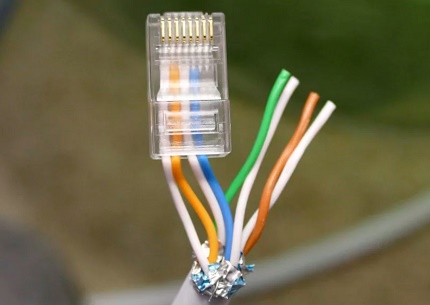
Faced with the need selection of electrical terminals for wires, it’s better to start with the simplest designs of domestic production - reliable, durable, proven in business more than once.
The following types of “clamps” are distinguished:
- knife;
- ring;
- pin;
- coupling.
Connections for the installation of electrical circuits can be performed by different methods and terminals - this is just one option. However, just such an option seems simple, convenient and even economical in comparison, for example, with soldering, welding, including cold.
Option # 1 - “scabbard”
These are perhaps the most common design options for products. They can often be found in the electrical circuits of many household appliances: irons, refrigerators, heating devices, etc.
But for conductor connections power electrical wiring, for example, in electrical apartment shields, they are not intended.
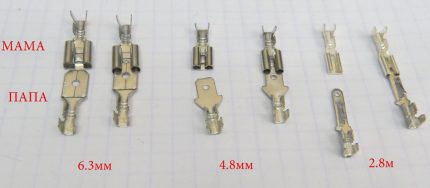
It is permissible to install this type of electrical products on conductors (stranded) with a cross section of 0.26 - 6.0 mm by the method of force crimping of the shank.
There are two types of such products: insulated and non-insulated. The insulation is usually colored in different colors (red, blue, yellow) depending on the rated power of the terminal block. The products are used in pairs in the “father-mother” bundle.
Option # 2 - Ring
Ring products are configured for screw mounting and are presented in two groups. Both groups are classified as bare terminals.
The first group includes designs of a closed ring with a shank. The second group consists of fork-type constructions with a break in the contour of the ring, also with a shank. Both that and others find wide application in circuits of electronic equipment.
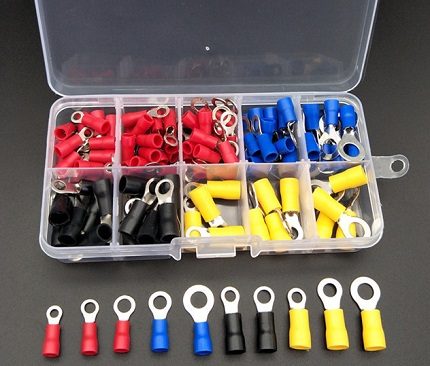
Ring terminal blocks of the first type are available in a wider range than the second type. And the possibilities for their application are more extensive, given the technical characteristics.
This type of electrical products may be installed on electrical conductors with a cross section of 0.25 - 16.8 mm. And the plug configuration of the connecting terminals for wires is designed only for a wire cross section of 0.25 - 4.6 mm.
Option # 3 - pin
This group of connecting terminals for electric wires is made according to the principle of a detachable part consisting of two separate elements - plugs and sockets.
The plug is marked with the symbol “A”, for example, F2A. The socket is marked with the symbol "B", for example, F2B. Mounting on conductors with a cross section of 1.25 - 6.64 mm is supported. The main purpose of the pin terminals is to ensure the connection of electrical conductors.
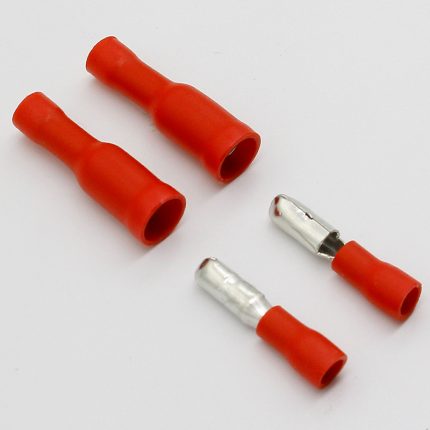
This group of mounting hardware refers to insulated products. The tail of the terminals is covered with insulating material. Depending on the rated power of the terminal strip for connecting the wires, the insulator has a corresponding color.
Electrical terminal insulators for conductors with a cross section of up to 2 mm are painted in blue, the rest (from 2 to 6.64 mm) - in yellow.
Option # 4 - Clutch Retainers
Another type of connecting fittings is a coupling contact retainer made in the form of a metal tube.
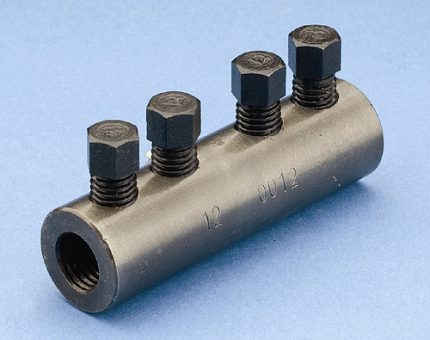
Couplings are designed for mounting on electrical conductors with a cross section of 0.25 - 16.78 mm.
Fixing is carried out by force crimping of a part of the tube or by means of bolts screwed into threaded holes on the coupling body. As a rule, crimp couplings are not used for connecting single-core wires.
Foreign Products
In recent years, the market has been filled with foreign-made terminal blocks. We must pay tribute: technologically foreign designs look more advanced than domestic products. It’s more convenient to work with them - faster and easier to make connections.
But from the point of view of the reliability of the connections made by a foreign product, not everything is so simple. In this regard, a domestic product often looks preferable. However, consider some examples.
Noteworthy electric company terminals Wago. The engineers of the company invented several attractive designs, where the ordinary terminal turns into a convenient interface for connecting: Push wire, Power cage clamp, Cage clamp.
Connector # 1 - Push Wire
Technology Push wire based on the use of the stiffness properties of the electrical conductor, due to which they get a completely reliable contact.
This type of terminal block is most suitable for working with a single-wire cable. Indeed, a quick way to connect Push Wire provides unconditionally.
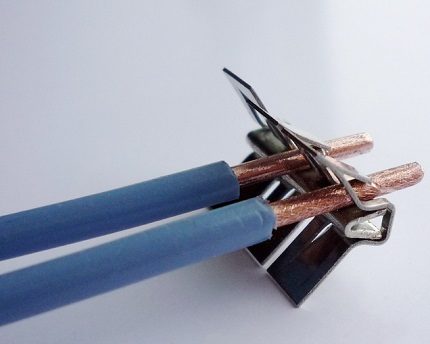
Just enough strip part of the wire (10-15 mm) and with a small effort push the stripped end into the terminal. And to just as quickly remove the conductor, it must be pulled out while scrolling around its axis.
Two types of Push Wire connectors have been developed:
- Under a single conductor.
- Under a group of conductors.
The group connection configuration is designed to work with wires of less rigidity than in the case of a single version. A slightly different construction of the mechanical clamp is used here.
To allow access to the conductor entry holes, you must apply some force to the push button. There are also models Push wire without a button - under the push action with a screwdriver.
Connector # 2 - Universal Power cage clamp
This terminal block belongs to the category of universal development. It is made for any type of electric wire with a cross section of 6 - 95 mm.
Constructively Power cage clamp It is a so-called double cage, where there is a spring press and a current-carrying bus.
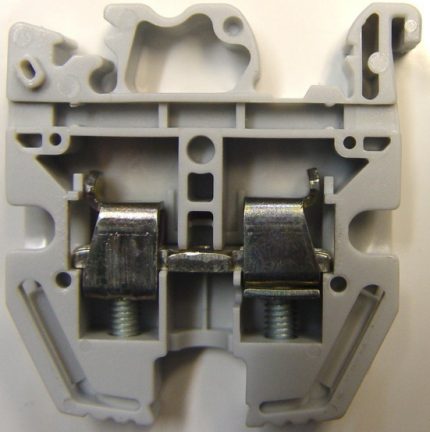
The electrical conductors are connected to such terminals using a hex key. By rotating the key, the spring is pressed, the end of the wire is inserted under the press, then the key is turned counterclockwise. As a result, the press is lowered and reliably presses the inserted end of the wire.
Connector # 3 - Stacked Cage clamp
It is unique, patented. Wago, a product that has received the characteristics of a type-setting terminal block for wires. WAGO terminal blocks are designed for installation on wires with a cross section of 0.5 - 35 mm.
They are well suited not only for working with a single-core wire, but also with multi-core wires, regardless of the degree of thinness of individual cores.
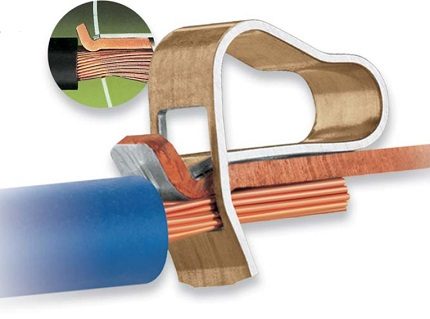
Is acting Cage clamp simple: with a screwdriver (or a special lever in other versions), the spring clip is lifted, the wire is inserted under the current-carrying bus, and then the clip is lowered into place. This product is type self-locking terminal blocks.
Despite the simplicity of the design, the manufacturer claims: the clamping force on the contact is automatically adjusted and directly depends on the cross-section of the wire.
Connector # 4 - Cage clamp S
An option for a wire connector is almost the same as the product described above. But the design Cage clamp s still somewhat different. The peculiarity of the “S” modification is manifested by the ability to work with this type of terminal without using any electrician tools.
Plus, the type-setting terminal block of the “S” modification is designed for conductors of sufficiently high rigidity - multicore and single-core. It is also permissible to connect wires with metal terminals to the terminal.
Working with Cage clamp S is very simple: the end (stripped) part of the conductor is inserted with some force until it stops, after which the connection is established.
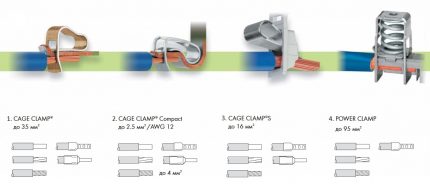
Connecting terminals for wires from the Cage clamp S series have found a place in almost all modifications of group multi-row terminal blocks.
They are conveniently used for the installation of numerous low-current electrical lines. However, the successfully closed Cage clamp S design is also used in high current circuits.
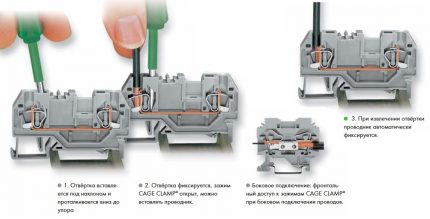
There are two modifications of the “S” construction completely enclosed in insulation. One involves securing the wire when wringing the plate in the front direction. Another is designed to perform lateral pressure with a screwdriver on a spring plate.
Screw Connectors
Screw connectors, which are essentially a variation of a tubular (sleeve) product, are widespread in the electrical industry. They are made in the form of a rectangular tube, but having a rounded (oval) bottom.
On the upper plateau of such a tube there are threaded holes where the locking screws are screwed. The whole structure is enclosed in kapron insulation. Through channels are made for access to the screws in the insulation body. There are two types of terminal blocks for connecting wires - single and group.
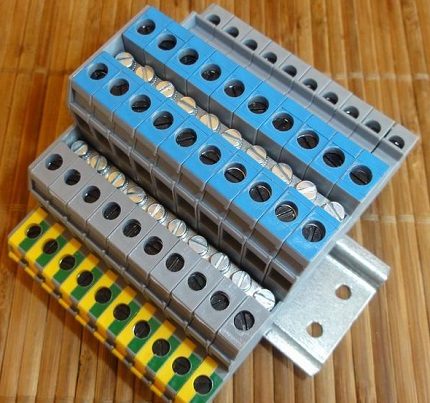
Screw terminal blocks for connecting wires are inherent in:
- pronounced mechanical strength;
- the ability to work with cables with a cross section up to 25 mm;
- use in circuits of low currents and power.
It’s easy to work with this type of connector.
The end parts of the wires are inserted inside the brass tube and the locking screws (usually two screws) are screwed in. In turn, the screws press the conductor to the bottom of the metal tube.
In addition to terminals, there are alternative methods for connecting wires. For more information on using terminal blocks and other non-soldering methods, see this article.
Conclusions and useful video on the topic
The presented video material will expand your knowledge about the types of terminals and how to install them.
Electrical work is rarely done without the use of the described accessories. It would seem that these are small parts that can be easily abandoned, replacing the technological connection with the usual twisting of wires.
But The practice of electrical engineering is marked by a mass of cases when it is a banal twist of conductors instead of a reliable terminal connection that leads to tragic consequences.
Have experience using terminals for connecting wires? Or have questions about the topic? Please share your opinion and leave comments. The communication unit is located below.

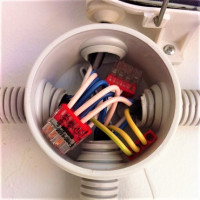 Wago terminal blocks: varieties and their characteristics + subtleties of connecting wires with Vago terminal blocks
Wago terminal blocks: varieties and their characteristics + subtleties of connecting wires with Vago terminal blocks 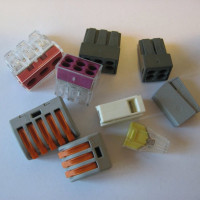 Self-locking terminal blocks: types and scope + recommendations for customers
Self-locking terminal blocks: types and scope + recommendations for customers 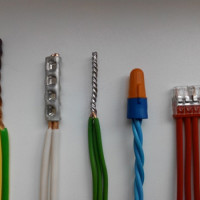 Methods of connecting electrical wires: types of connections + technical nuances
Methods of connecting electrical wires: types of connections + technical nuances 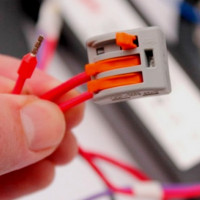 Wire connectors: the best types of connectors + what to look at when choosing a connector
Wire connectors: the best types of connectors + what to look at when choosing a connector 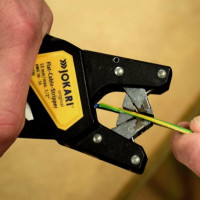 Stripper for stripping wires: rules for selecting a tool for stripping cable and wires
Stripper for stripping wires: rules for selecting a tool for stripping cable and wires 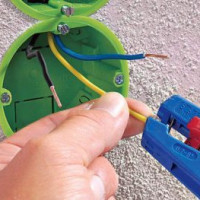 Stripping wires from insulation: methods and specifics of removing insulation from cables and wires
Stripping wires from insulation: methods and specifics of removing insulation from cables and wires 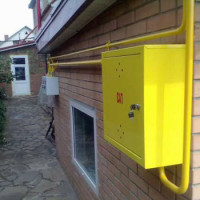 How much does it cost to connect gas to a private house: the price of organizing gas supply
How much does it cost to connect gas to a private house: the price of organizing gas supply  The best washing machines with dryer: model rating and customer tips
The best washing machines with dryer: model rating and customer tips 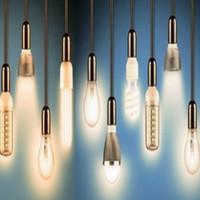 What is the color temperature of light and the nuances of choosing the temperature of the lamps to suit your needs
What is the color temperature of light and the nuances of choosing the temperature of the lamps to suit your needs 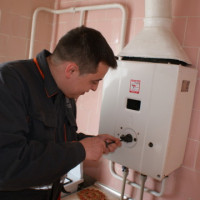 Replacement of a geyser in an apartment: replacement paperwork + basic norms and requirements
Replacement of a geyser in an apartment: replacement paperwork + basic norms and requirements
I am not an expert; I have not even seen most of the terminals shown here. And in general, it is not entirely clear why they are described. The name is “which terminal blocks are better and how to work with them”, but about the terminal blocks only a little in the video. I think the topic is completely unsolved. And the topic is interesting and relevant. Pros, cons, in what situations what and why, the price. It would be nice to read.
Good day, Sergey.
After your comment, I re-read the article. Your conclusion is unfounded - the first section states: it is better to choose domestic ones. The following is an explanation: tested by operation, reliable, durable.
Describing the terminals, the author ties the type of product to the situation - these are used in irons, coffee makers, they can be found in electronics, etc.
A separate section is devoted to foreign products. Here the author emphasizes: they look more perfect than domestic ones, easier to install, but ... then follow the conclusions, which, judging by the recall, were not enough for you.
Prices, I agree, no, but today's pegging of the ruble to the dollar is forcing manufacturers to systematically adjust the cost of the product.
Screenshot with key points attached.
In our time, terminal blocks were simply called: twisting, soldered or not, on top of the electrical tape. Now my eyes are running wide, you do not know which one to use. The first appeared screw connectors: very convenient, how many wires, how many tubes you cut. There are through holes for attaching to the panel. In old apartments, in junction boxes, twists were isolated with caps like ballpoint pens. Based on them, connectors were made that were wound onto a group of wires. Hold well. They are of different sizes, so they are suitable for any sections. Typically, terminal blocks are used for plug-in connections of boards, motors, etc.